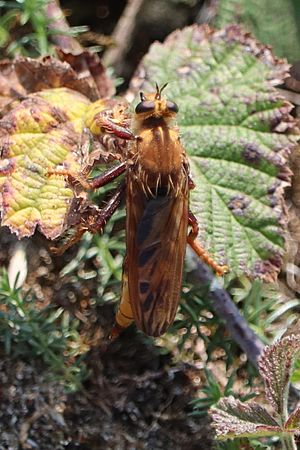Hornet robberfly facts for kids
Quick facts for kids Hornet robberfly |
|
|---|---|
 |
|
| Asilus crabroniformis | |
| Scientific classification | |
| Kingdom: | |
| Phylum: | |
| Class: | |
| Order: | |
| Family: |
Asilidae
|
| Subfamily: |
Asilinae
|
| Genus: |
Asilus
|
| Species: |
A. crabroniformis
|
| Binomial name | |
| Asilus crabroniformis Linnaeus, 1758
|
|
The hornet robberfly, Asilus crabroniformis, is a fascinating insect. It's a type of fly that hunts other insects. This fly is known for looking a bit like a hornet, but it's actually harmless to humans.
Contents
About the Hornet Robberfly
The hornet robberfly is one of the largest flies found in the United Kingdom. It can grow to be more than 25 millimeters long. This makes it quite a big insect to spot!
What it Looks Like
The hornet robberfly gets its name because it looks a bit like a hornet. However, there are key differences. A real hornet has two pairs of wings. The robberfly only has one pair. It also has just one yellow patch on its body. This helps you tell it apart from a stinging hornet.
What it Eats
This fly is a "predator." This means it hunts and eats other insects. It enjoys eating grasshoppers and dung beetles. It also preys on other flies.
Life Cycle
The young hornet robberflies are called larvae. Scientists believe these larvae eat the larvae of dung beetles. They might also eat other small creatures that feed on decaying matter.
Where it Lives
You can find the hornet robberfly in certain parts of Southern England and South & West Wales. It likes open areas in woodlands. It also lives in dry, grassy places like heaths and downs.
This fly needs rabbit or cattle dung to survive. The dung is important for the dung beetles. The dung beetle larvae are food for the hornet robberfly larvae.
Conservation Status
The hornet robberfly belongs to the Asilidae family. This family is known as the "robberflies." The hornet robberfly is an important part of its ecosystem. It is currently on the list of endangered species in the British Isles. This means efforts are being made to protect it.
See also
 In Spanish: Asilus crabroniformis para niños
In Spanish: Asilus crabroniformis para niños

